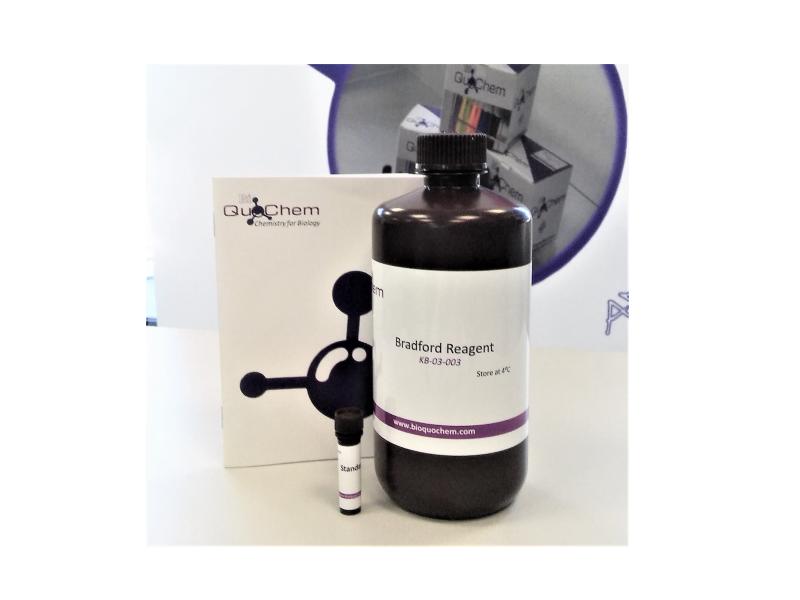Bradford Protein
Reference : KB03003
Bradford Protein Quantification Assay Kit is based on the direct binding of Coomassie brilliant blue G-250 dye to proteins at arginine, tryptophan, tyrosine, histidine, and phenylalanine residues. Specifically, the anionic dye binds to these residues producing an absorbance maximum at 595 nm.
The dye interacts with the protein via van der Waals forces between the hydrophobic regions of the protein and the nonpolar region of the dye, and the electrostatic interaction between the negatively charged dye and positively charged amino groups of protein. The formation of the dye-protein complex takes about two minutes and remains stable for an hour, so the procedure is very fast and the time for trial is not limiting. Additionally, the dye-protein complex has a high extinction coefficient, which makes it a very sensitive assay.
It should be pointed that highly alkaline buffers present interference. on the other hand, reagents as magnesium chloride, potassium, sodium, ammonium sulfate and ethanol has no effect on the assay. In addition, other reagents such as Tris, acetic acid, 2-mercaptoethanol, sucrose, glycerol, EDTA and traces of detergents Triton® X-100, sodium dodecyl sulphate (SDS) and Hemosol have light effects that can be easily removed.
List of Reagents compatible with the kit protein assay when the standard procedure is used:
Chapso, 10%
Octyl β-thioglucopyranoside, 1%
Deoxycholic acid, 0.2%
PBS
DMSO, 5%
Phenol Red, 0.5 mg/mL
Dithioerythritol(DTE), 10 mM
PIPES, 0.2 M
Dithiothreitol (DTT), 10 mM
PMSF, 2 mM
Eagle´s MEM
Potassium chloride, 2 M
Earle´s salt solution
Potassium phosphate, 0.5 M
EDTA, 0.2 M
SB 3-10, 0.1%
EGTA 0.2 M
SDS 0.025%
Ethanol, 10%
Sodium acetate, pH 4.8, 0.2 M
Glucose, 20%
Sodium azide, 0.5%
Glycerol, 5%
Sodium bicarbonate, 0.2 M
Glycine, 0.1M
Sodium Carbonate, 0.1 M
Guanidine-HCl, 2M
Sodium Chloride, 2.5 M
Hank´s salt solution,
Sodium citrate pH4.8 or6.4,0.2 M
HCl, 0.1M
Sodium Hydroxide, 0.1M
HEPES 0.1M
Sodium Phosphate, 0.5M
Imidazole 0.2M
Sucrose, 10%
Magnesium chloride
TBP 5mM
MES, 0.1M
TBS (25mM Tris, 0.15M NaCl, pH 7.6), 0.5x
Methanol 10%
TCEP, 20mM
Modified Dulbecco´s PBS
Thio-urea, 1M
MOPS, 0.1M
Tricine, pH 8, 50mM
Triethanolamine, pH 7.8, 50mM
Triton® X-100, 0.05%
Tris, 1M
Tween® 20, 0.01%
Tris-glycine (25mM Tris, 192mM glycine)
Urea, 4M
Tris-glycine-SDS (25mM Tris,192mMglycine, 0.1%SDS), 0.5x
The documents available in this section are provided for information only and are subject to change. Please contact us for the latest updates.
If you have just received a kit or product without technical instructions in paper format, this means that the instructions have been dematerialized.
In this case, please download it and refer only to the version you can download from the product page of the manufacturer's website, or by scanning the QR code present on the product.
Regarding any certificates of analysis, safety data sheets or spreadsheets, please contact us to obtain the latest versions.
If you have any questions, our team is at your disposal.
Specifications
| Reference | Packaging | |
|---|---|---|
| KB03003-2000 | 2000 tests (96 puits/wells format) | |
| KB03003-4000 | 4000 tests (96 puits/wells format) |

